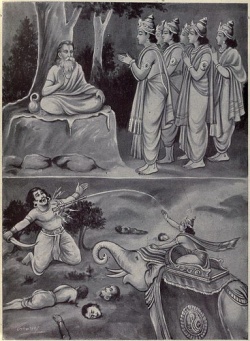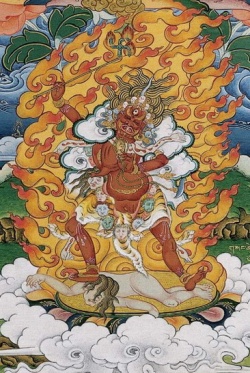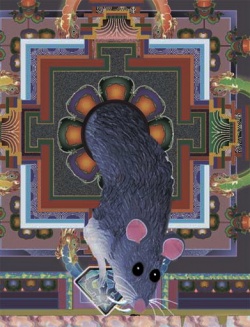Vritra
In the early Vedic Religion, Vritra (Vṛtra वृत्र "the enveloper"), is an Asura and also a serpent or dragon, the personification of drought and enemy of Indra.
Vritra was also known in the Vedas as Ahi ("snake"). He appears as a dragon blocking the course of the Rivers and is heroically slain by Indra.
Vedic version
According to the Rig Veda, Vritra kept the waters of the World captive until he was killed by Indra, who destroyed all the 99 fortresses of Vritra (although the fortresses are sometimes attributed to Sambara) before liberating the imprisoned rivers.
The combat began soon after Indra was born, and he had drunk a large volume of Soma at Tvashtri's house to empower him before facing Vritra.
Tvashtri fashioned the thunderbolt (Vajrayudha) for Indra, and Vishnu, when asked to do so by Indra, made space for the battle by taking the three great strides for which Vishnu became famous.
Vritra broke Indra's two jaws during the battle, but was then thrown down by Indra and, in falling, crushed the fortresses that had already been shattered.
For this feat, Indra became known as Vritrahan "slayer of Vritra" and also as "slayer of the first-born of Dragons". Vritra's mother, Danu (who was also the mother of the Danava race of Asuras), was then attacked and defeated by Indra with his thunderbolt.
In one of the versions of the story, three Devas - Varuna, Soma and Agni - were coaxed by Indra into aiding him in the fight against Vritra whereas before they had been on the side of Vritra (who they called "Father").
In one verse of a Rig-Vedic hymn eulogising Sarasvati, the latter is credited with the slaying of Vritra. Mention of this occurs nowhere else.
Puranic & later versions
In a later version of the myth, Vritra was created by Tvashtri to avenge the killing of his son by Indra, known as Trisiras or Visvarupa. Vritra won the battle and swallowed Indra, but the other gods forced him to vomit Indra out.
The battle continued and Indra was eventually forced to flee. Vishnu and the rishis brokered a truce, with Indra swearing that he would not attack Vritra with anything made of metal, wood or stone, nor anything that was dry or wet, or during the day or the night.
Indra used the foam (which Vishnu had entered to ensure victory) from the waves of the ocean to kill him at twilight.
However, in some places, Hindu scriptures also recognize Vritra as a bhakta of Vishnu who was slain only due to his failure to live piously and without aggression. This story runs thus:
Vritra (a Brahmin in this version) became the head of the Asuras (portrayed as inherently demonic here, as opposed to the Vedic version in which they can be gods or demons).
He renounced his Dharma – duty – to do good unto others and turned to violence, battling with the devas.
Eventually, he gained the upper hand and the Devas were frightened of his Evil might.
Led by Indra, they approached Lord Vishnu for help. He told them that Vritra could not be destroyed by ordinary means, revealing that only a weapon made from the bones of a sage could slay him.
When the deities revealed their doubts about the likelihood of any Ascetic donating his Body, Vishnu directed them to approach the sage (Rishi) Dadichi.
When approached by the gods, Dadhichi gladly gave up his bones for the cause of the good, stating that it would be better for his bones to help them attain victory than to rot in the ground.
The Devas collected the bones and Indra crafted the Vajrayudha from them. When they engaged Vritra again, the battle lasted for 360 days before the Brahmin breathed his last.
In both of these versions (either for killing Trisiras or the Brahmin Vritra), the terrible anthropomorphic personification of Brāhmanahatya (Brahmanicide) chased Indra and forced him into hiding for his sin, and Nahusha was invited to take his place.


